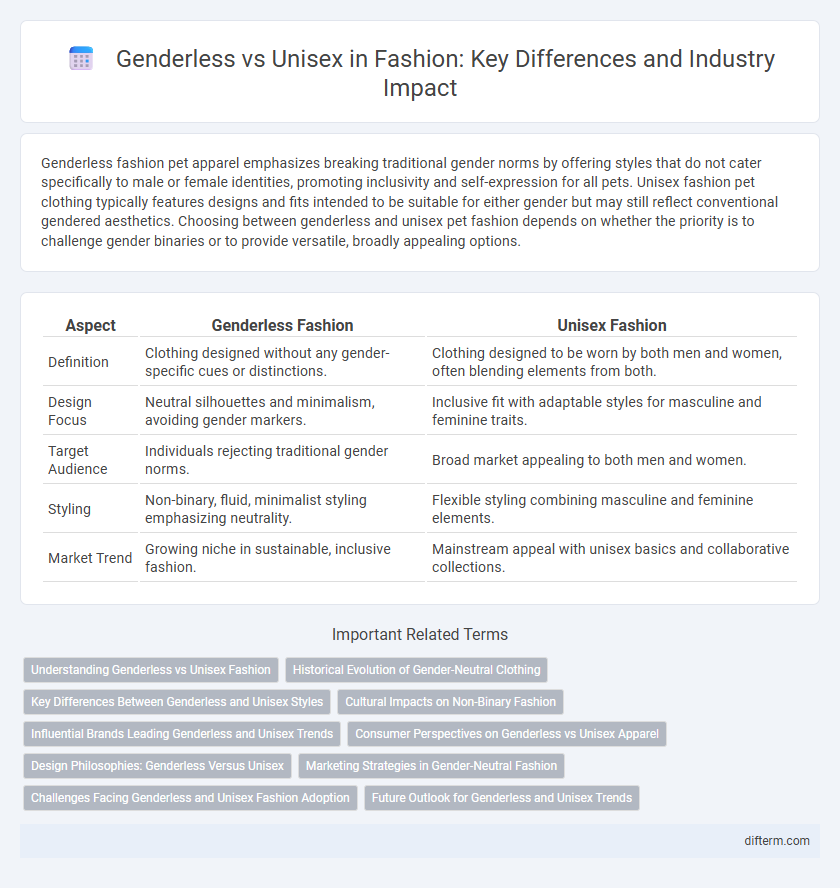Genderless fashion pet apparel emphasizes breaking traditional gender norms by offering styles that do not cater specifically to male or female identities, promoting inclusivity and self-expression for all pets. Unisex fashion pet clothing typically features designs and fits intended to be suitable for either gender but may still reflect conventional gendered aesthetics. Choosing between genderless and unisex pet fashion depends on whether the priority is to challenge gender binaries or to provide versatile, broadly appealing options.
Table of Comparison
| Aspect | Genderless Fashion | Unisex Fashion |
|---|---|---|
| Definition | Clothing designed without any gender-specific cues or distinctions. | Clothing designed to be worn by both men and women, often blending elements from both. |
| Design Focus | Neutral silhouettes and minimalism, avoiding gender markers. | Inclusive fit with adaptable styles for masculine and feminine traits. |
| Target Audience | Individuals rejecting traditional gender norms. | Broad market appealing to both men and women. |
| Styling | Non-binary, fluid, minimalist styling emphasizing neutrality. | Flexible styling combining masculine and feminine elements. |
| Market Trend | Growing niche in sustainable, inclusive fashion. | Mainstream appeal with unisex basics and collaborative collections. |
Understanding Genderless vs Unisex Fashion
Genderless fashion eliminates traditional gender distinctions by creating clothing designed for anyone, emphasizing inclusivity and self-expression. Unisex fashion specifically refers to garments intended to be worn by both men and women, often blending elements from masculine and feminine styles. Understanding the difference highlights how genderless fashion challenges societal norms more broadly, while unisex fashion focuses on practical versatility.
Historical Evolution of Gender-Neutral Clothing
The historical evolution of gender-neutral clothing traces back to early 20th-century avant-garde movements challenging traditional gender norms through androgynous styles. The 1960s and 1970s saw unisex fashion emerge prominently, driven by cultural shifts toward equality and self-expression, with designers like Yves Saint Laurent introducing tuxedos for women. Contemporary fashion continues this trajectory, blending genderless aesthetics with inclusivity, reflecting societal progress in breaking down binary gender barriers.
Key Differences Between Genderless and Unisex Styles
Genderless fashion eliminates traditional gender categories, creating pieces that do not conform to any specific gender identity, while unisex style designs clothing that fits both males and females but still draws from existing gendered norms. Key differences include the intention behind design--genderless aims for neutrality and fluidity beyond conventional gender roles, whereas unisex offers shared silhouettes and patterns adapted from masculine or feminine styles. Fabric choices, cuts, and marketing strategies further highlight genderless fashion's focus on inclusivity and individuality compared to unisex's emphasis on versatility and broad appeal.
Cultural Impacts on Non-Binary Fashion
Non-binary fashion challenges traditional gender norms by embracing inclusivity and fluidity, reflecting broader cultural shifts toward acceptance and diversity. Genderless styles reject binary classifications, allowing individuals to express identity beyond societal expectations, which fosters a more open dialogue around gender and personal expression. The rise of non-binary fashion influences the fashion industry to create versatile, adaptable clothing that transcends gender-specific design, promoting cultural awareness and social progress.
Influential Brands Leading Genderless and Unisex Trends
Influential brands like Telfar, Gucci, and Rad Hourani are pioneering genderless and unisex fashion by breaking traditional style boundaries and promoting inclusivity. These labels emphasize fluid silhouettes, neutral palettes, and versatile designs that resonate with diverse audiences, challenging the binary norms of fashion. Their innovative approach catalyzes industry-wide shifts towards more sustainable and expressive clothing options, redefining modern wardrobe essentials.
Consumer Perspectives on Genderless vs Unisex Apparel
Consumer perspectives on genderless apparel emphasize inclusivity and personal expression, appealing to individuals who reject traditional gender norms and seek fluidity in fashion choices. Unisex apparel, while designed for a broad audience, often retains subtle gendered elements, causing some consumers to favor fully genderless designs for authentic neutrality. Market trends indicate a growing demand for genderless clothing, driven by younger generations prioritizing sustainability, diversity, and breaking away from binary fashion constraints.
Design Philosophies: Genderless Versus Unisex
Genderless design philosophy in fashion prioritizes fluidity and inclusivity by eliminating traditional gender distinctions, allowing clothing to transcend binary norms through adaptable silhouettes and neutral color palettes. Unisex design, while also bridging gender gaps, often merges masculine and feminine styles but maintains recognizable elements from both, targeting a shared aesthetic rather than a completely non-gendered approach. Both philosophies challenge conventional fashion norms, yet genderless design pushes boundaries further by emphasizing identity expression beyond gender categories.
Marketing Strategies in Gender-Neutral Fashion
Marketing strategies in gender-neutral fashion emphasize inclusivity by using diverse models and avoiding traditional gender stereotypes in campaigns. Brands leverage social media platforms to engage a broad audience, promoting self-expression and fluidity in style choices. Product descriptions focus on versatility and comfort, appealing to consumers seeking authenticity beyond binary fashion norms.
Challenges Facing Genderless and Unisex Fashion Adoption
Genderless and unisex fashion faces challenges such as societal resistance rooted in rigid gender norms and limited inclusivity in mainstream retail channels. The lack of diverse sizing and representation often hampers consumer acceptance and restricts market growth. Overcoming these barriers requires brands to prioritize adaptive designs and inclusive marketing strategies that resonate across all gender identities.
Future Outlook for Genderless and Unisex Trends
The future outlook for genderless and unisex fashion trends highlights an increasing consumer demand for inclusive and sustainable clothing options that transcend traditional gender boundaries. Major brands and designers are investing in innovative textiles and versatile silhouettes, reflecting a shift towards personalized, adaptable wardrobes. Market analyses predict that the global unisex fashion market will grow significantly, driven by younger generations' preference for non-binary expression and ethical consumption.
genderless vs unisex Infographic

 difterm.com
difterm.com